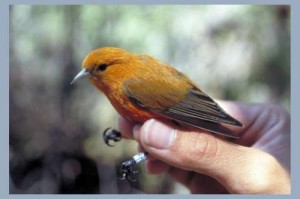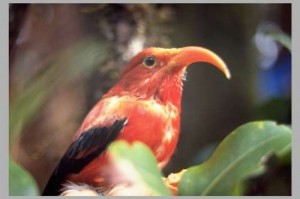USGS: CLIMATE CHANGE THREATENS ENDANGERED HONEYCREEPERS
A new report released by the U.S. Geological Survey says climate change could pose a threat to Hawaii’s endangered Honeycreeper population.

Title: Akepa Honeycreeper Description: While the susceptibility of endangered akepa honeycreepers to avian malaria is unknown, it is likely very high given their current restriction to the highest elevation forests on the island of Hawaii. Location: USA Photographer: Carter Atkinson, U.S. Geological Survey
According to the study, increased temperatures in Hawaii’s mountains would likely result in deadly non-native bird diseases creeping up the mountains.
Researchers say current populations enjoy cool, high-elevations where mosquitoes do not thrive; but an increase in climatic conditions could result in a rise in pox and malaria transmission.
Researchers say the low-risk disease zone at Hanawi Natural Area Reserve on Maui would likely decline by nearly 60 percent if a projected 3.6 degree rise in temperature occurs,.
Similarly, the Hakalau Forest National Wildlife Refuge on Hawaii Island could decline by as much as 96 percent. Researchers go further to say that other islands, such as Kauai, with lower elevations and no low-risk zones would likely experience catastrophic effects on the remaining honeycreeper species with the predicted temperature changes.
“Without question, the one factor that prevented widespread and rapid extinction of virtually all of Hawaii’s native honeycreepers after the introduction of avian pox and avian malaria was the presence of high-altitude disease refuges on Kauai, Maui and Hawaii,” said lead study author Dr. Carter Atkinson, a USGS microbiologist based at the USGS Pacific Islands Ecosystems Research Center in Hawaii.

Title: Iiwi Honeycreeper Description: While still common at higher elevations, iiwi are extremely susceptible to avian malaria. Mortality is as high as 90% after exposure to a single infective mosquito bite under laboratory conditions. Location: USA Photographer: Carter Atkinson, U.S. Geological Survey
These cool, high-elevation – above 4,000 feet (1,200 meters) — mountains not only provided habitats that mosquitoes didn’t thrive in, but they also had habitat that honeycreepers liked, wrote the authors. While birds in those areas find refuge from the diseases – dispersing juvenile birds and adults that follow seasonal flowering of native plants to lower elevations are exposed to disease.
“Unfortunately,” said study co-author, USGS scientist Dr. Dennis LaPointe, “this seasonal movement happens at the same time that mosquito populations soar at mid-elevations, which fuels high disease-transmission rates there. There’s a continuous source of disease-susceptible birds each fall.”
“Right now, disease transmission in the mountains of Kaui is highly seasonal, but with temperature increases, disease would be able to be transmitted throughout most of the year,” said Atkinson.
In addition, the tropical inversion layer – often visible as a thin cloud layer around high peaks — may play a more significant role than temperature in determining tree line and the upper extent of forest bird habitat, the authors wrote. The inversion layer forms as cool, dry air meets warm, moist air, creating an inversion layer that caps moisture and cloud development between 5,900 and 7,900 feet (1,800 and 2,400 meters). Over the past 24 years, the height of this layer has remained fairly stable in spite of warming trends but has increased in how often it occurs.
“This could have a tremendous adverse effect on the continued existence of high-elevation disease refugia,” said Atkinson. “Remaining bird populations could be squeezed between expanding disease transmission from lower elevations and the upper limits of suitable forest habitat. Such changes would likely push remaining populations of threatened and endangered honeycreepers to extinction, and cause severe declines in other honeycreepers not now endangered but susceptible to avian malaria.”
Given the likelihood of global warming, the authors suggested that management of mid-elevation habitats to reduce disease transmission will become increasingly vital. The best opportunities for doing this, they wrote, will be through reducing habitat for mosquito larvae, habitat that is often created by introduced feral pigs, goats and cattle in forests.
“The survival of these species into the next century may ultimately depend on our ability to remove or offset introduced threats and restore native forests from sea level to tree line,” Atkinson said.
Honeycreepers rival Darwin’s finches in the Galapagos Islands in terms of their bill types and number of species that descended from a common founder. The birds specialize on food that includes nectar, fruits and insects. Before people came to the islands, as many as 56 kinds of honeycreepers probably occurred.
Avian malaria is caused by a protozoan parasite, and avian pox is a viral infection that typically causes tumor-like swellings on exposed skin of the feet, legs, beak and eyelids of infected birds. Malaria often results in appetite and weight loss, anemia, and massive enlargement of birds’ liver and spleen.
(The article, Introduced avian diseases, climate change, and the future of Hawaiian honeycreepers, was published in the Journal of Avian Medicine and Surgery.)
(Posted by Wendy OSHER © 2009; Images courtesy USGS)






_1709057595069.webp)



